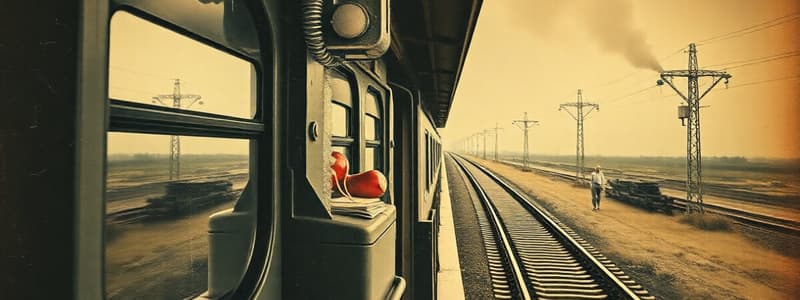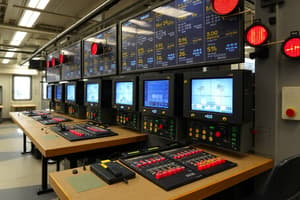Podcast
Questions and Answers
What is the primary function of the Loco KAVACH unit in the communication process?
What is the primary function of the Loco KAVACH unit in the communication process?
- To initiate communication delays for safety
- To receive packets from the Stationary KAVACH unit (correct)
- To transmit emergency signals only
- To establish direct links between stations
How many time slots are allocated for communication between Stationary KAVACH and Loco KAVACH?
How many time slots are allocated for communication between Stationary KAVACH and Loco KAVACH?
- 30
- 50 (correct)
- 100
- 78
What determines the number of time slots allocated to a station within the KAVACH system?
What determines the number of time slots allocated to a station within the KAVACH system?
- The size of the station (correct)
- The health of the KAVACH units
- The distance from the next station
- The age of the communication system
What type of structure are the RF Communication towers primarily built as?
What type of structure are the RF Communication towers primarily built as?
At what height are the radios installed in the Radio Tower Unit?
At what height are the radios installed in the Radio Tower Unit?
What is the width of each time slot marker in the KAVACH communication system?
What is the width of each time slot marker in the KAVACH communication system?
How many basic time slot position markers are there in the frame cycle?
How many basic time slot position markers are there in the frame cycle?
What connects the radios to the Station KAVACH?
What connects the radios to the Station KAVACH?
What is a key feature of the NMS regarding train movement display?
What is a key feature of the NMS regarding train movement display?
What happens when both RFID tags of a set are missing according to the NMS?
What happens when both RFID tags of a set are missing according to the NMS?
What system is used for time synchronization in the KAVACH system?
What system is used for time synchronization in the KAVACH system?
Which of the following alerts is NOT generated by the NMS?
Which of the following alerts is NOT generated by the NMS?
How does the NMS support data collection?
How does the NMS support data collection?
In the event of a communication failure, what is a consequence within the KAVACH system?
In the event of a communication failure, what is a consequence within the KAVACH system?
What type of reports can the NMS generate?
What type of reports can the NMS generate?
What is the importance of GPS antenna installation in stationary KAVACH units?
What is the importance of GPS antenna installation in stationary KAVACH units?
What should the Loco KAVACH unit do if both RFID readers fail?
What should the Loco KAVACH unit do if both RFID readers fail?
What action does the Loco KAVACH unit take if one RFID reader fails?
What action does the Loco KAVACH unit take if one RFID reader fails?
How does the Loco KAVACH unit respond if both GPS/GNSS and Real Time Clock (RTC) fail?
How does the Loco KAVACH unit respond if both GPS/GNSS and Real Time Clock (RTC) fail?
What should the Loco KAVACH unit do if there is an incremental time difference greater than the frame interval between CPU time and GPS time?
What should the Loco KAVACH unit do if there is an incremental time difference greater than the frame interval between CPU time and GPS time?
What is the fallback time duration for the Loco KAVACH unit to use CPU time when both GPS systems fail?
What is the fallback time duration for the Loco KAVACH unit to use CPU time when both GPS systems fail?
What happens when there is a communication failure with the Active Cab/Desk DMI?
What happens when there is a communication failure with the Active Cab/Desk DMI?
If only one radio fails and another is operational, what should the Loco KAVACH unit do?
If only one radio fails and another is operational, what should the Loco KAVACH unit do?
What should the Loco KAVACH unit prefer to avoid common cause failures in GPS systems?
What should the Loco KAVACH unit prefer to avoid common cause failures in GPS systems?
What generates dynamic IP addresses for the Onboard KAVACH (OVK)?
What generates dynamic IP addresses for the Onboard KAVACH (OVK)?
What is the purpose of the redundant architecture in the OFC network?
What is the purpose of the redundant architecture in the OFC network?
Which component is responsible for handling both IPV4 and IPV6 addresses?
Which component is responsible for handling both IPV4 and IPV6 addresses?
What does the Onboard KAVACH (OVK) communicate when entering KAVACH territory?
What does the Onboard KAVACH (OVK) communicate when entering KAVACH territory?
What information does the Loco Exchange Server (LES) use to populate its lookup table?
What information does the Loco Exchange Server (LES) use to populate its lookup table?
What type of communication is established between SVK and OVK after an access request is received?
What type of communication is established between SVK and OVK after an access request is received?
How far does the geographical region cover for locos managed by Loco Exchange Server?
How far does the geographical region cover for locos managed by Loco Exchange Server?
What occurs when the OVK receives the IP address from KAS for a stationary KAVACH?
What occurs when the OVK receives the IP address from KAS for a stationary KAVACH?
What encryption method is utilized between Loco KAVACH and Stationary KAVACH?
What encryption method is utilized between Loco KAVACH and Stationary KAVACH?
What is the maximum size of communication packets between Station KAVACH and Loco KAVACH?
What is the maximum size of communication packets between Station KAVACH and Loco KAVACH?
Which type of communication media is used between Station KAVACH and SM OCIP?
Which type of communication media is used between Station KAVACH and SM OCIP?
What cable size is employed for data transmission by the RFID reader and Tachometer?
What cable size is employed for data transmission by the RFID reader and Tachometer?
How will loco-to-loco communication be held?
How will loco-to-loco communication be held?
What device is used for radio connectivity at HFZ station and LPI?
What device is used for radio connectivity at HFZ station and LPI?
What height are radio modems typically placed at?
What height are radio modems typically placed at?
Which frequencies are utilized in Kavach UHF communication between station and loco?
Which frequencies are utilized in Kavach UHF communication between station and loco?
What is the primary function of the Stationary KAVACH unit at level crossing gates and IBS locations?
What is the primary function of the Stationary KAVACH unit at level crossing gates and IBS locations?
How does the Stationary KAVACH unit determine the movement authority?
How does the Stationary KAVACH unit determine the movement authority?
What happens when the Stationary KAVACH unit detects a Red (Danger) signal?
What happens when the Stationary KAVACH unit detects a Red (Danger) signal?
What technology does the Stationary KAVACH communicate with to transmit movement authority?
What technology does the Stationary KAVACH communicate with to transmit movement authority?
What must the Loco KAVACH unit do when it receives a signal to decrease its movement authority?
What must the Loco KAVACH unit do when it receives a signal to decrease its movement authority?
Why is the length of movement authority determined based on the signal aspect?
Why is the length of movement authority determined based on the signal aspect?
What is one key role of the Loco KAVACH unit's Driver Machine Interface (DMI)?
What is one key role of the Loco KAVACH unit's Driver Machine Interface (DMI)?
In case of conflicting signals or track information, what does the Stationary KAVACH unit do?
In case of conflicting signals or track information, what does the Stationary KAVACH unit do?
Flashcards
Stationary KAVACH unit
Stationary KAVACH unit
A dedicated KAVACH unit placed at specific locations like level crossing gates or intermediate block signaling points.
Remote Interface Unit (RIU)
Remote Interface Unit (RIU)
A device used to remotely transmit signaling information to a nearby Stationary KAVACH unit in cases where radio coverage is limited.
Direction of movement
Direction of movement
The Stationary KAVACH determines the direction of a train's movement to identify the approaching signal.
Movement authority
Movement authority
Signup and view all the flashcards
Movement authority transmission
Movement authority transmission
Signup and view all the flashcards
Speed profile/brake curve
Speed profile/brake curve
Signup and view all the flashcards
Driver Machine Interface (DMI)
Driver Machine Interface (DMI)
Signup and view all the flashcards
Red signal and movement authority
Red signal and movement authority
Signup and view all the flashcards
What is f0 used for?
What is f0 used for?
Signup and view all the flashcards
Where are RF Communication towers located?
Where are RF Communication towers located?
Signup and view all the flashcards
What is the antenna configuration of the communication towers?
What is the antenna configuration of the communication towers?
Signup and view all the flashcards
Describe the time slots used for communication in KAVACH.
Describe the time slots used for communication in KAVACH.
Signup and view all the flashcards
How are time slots assigned to stations?
How are time slots assigned to stations?
Signup and view all the flashcards
How does communication between Station KAVACH and Loco KAVACH occur?
How does communication between Station KAVACH and Loco KAVACH occur?
Signup and view all the flashcards
What are fS1-fM1, fS2-fM2, fSn-fMn?
What are fS1-fM1, fS2-fM2, fSn-fMn?
Signup and view all the flashcards
How are the radios connected to the Station KAVACH?
How are the radios connected to the Station KAVACH?
Signup and view all the flashcards
What happens if the Stationary KAVACH unit encounters a fault?
What happens if the Stationary KAVACH unit encounters a fault?
Signup and view all the flashcards
What happens if both RFID readers fail on the Loco KAVACH unit?
What happens if both RFID readers fail on the Loco KAVACH unit?
Signup and view all the flashcards
What happens if one RFID reader on the Loco KAVACH fails?
What happens if one RFID reader on the Loco KAVACH fails?
Signup and view all the flashcards
How does the Stationary KAVACH unit synchronize with other KAVACH systems?
How does the Stationary KAVACH unit synchronize with other KAVACH systems?
Signup and view all the flashcards
What happens when both GPS/GNSS and the Real Time Clock (RTC) fail on the Loco KAVACH?
What happens when both GPS/GNSS and the Real Time Clock (RTC) fail on the Loco KAVACH?
Signup and view all the flashcards
What happens if the Loco KAVACH unit loses both GPS systems and cannot stabilize?
What happens if the Loco KAVACH unit loses both GPS systems and cannot stabilize?
Signup and view all the flashcards
What happens when the Driver Machine Interface (DMI) communication fails?
What happens when the Driver Machine Interface (DMI) communication fails?
Signup and view all the flashcards
How does the Loco KAVACH unit react to an Active Cab/ Desk DMI communication failure?
How does the Loco KAVACH unit react to an Active Cab/ Desk DMI communication failure?
Signup and view all the flashcards
What is NMS?
What is NMS?
Signup and view all the flashcards
Why is Time Synchronization important in KAVACH?
Why is Time Synchronization important in KAVACH?
Signup and view all the flashcards
How is Time Synchronization achieved in KAVACH?
How is Time Synchronization achieved in KAVACH?
Signup and view all the flashcards
What components in KAVACH have RTC synchronization?
What components in KAVACH have RTC synchronization?
Signup and view all the flashcards
How is High Availability of GPS/GNSS achieved in KAVACH?
How is High Availability of GPS/GNSS achieved in KAVACH?
Signup and view all the flashcards
What happens if both GPS/GNSS and RTC fail?
What happens if both GPS/GNSS and RTC fail?
Signup and view all the flashcards
What happens if the Active Cab/Desk DMI communication fails?
What happens if the Active Cab/Desk DMI communication fails?
Signup and view all the flashcards
How can data logs be extracted from NMS?
How can data logs be extracted from NMS?
Signup and view all the flashcards
Stationary KAVACH (SVK)
Stationary KAVACH (SVK)
Signup and view all the flashcards
Onboard KAVACH (OVK)
Onboard KAVACH (OVK)
Signup and view all the flashcards
EPC (Evolved Packet Core)
EPC (Evolved Packet Core)
Signup and view all the flashcards
Railway's L3 VPN (Virtual Private Network)
Railway's L3 VPN (Virtual Private Network)
Signup and view all the flashcards
Loco ID
Loco ID
Signup and view all the flashcards
Loco Exchange Server (LES)
Loco Exchange Server (LES)
Signup and view all the flashcards
Dynamic Lookup Table
Dynamic Lookup Table
Signup and view all the flashcards
KAVACH Application Server (KAS)
KAVACH Application Server (KAS)
Signup and view all the flashcards
Maximum packet size between S KAVACH and L KAVACH
Maximum packet size between S KAVACH and L KAVACH
Signup and view all the flashcards
FSC input capacity in HBL Stationary KAVACH
FSC input capacity in HBL Stationary KAVACH
Signup and view all the flashcards
Purpose of E1 connection in Station KAVACH
Purpose of E1 connection in Station KAVACH
Signup and view all the flashcards
Communication medium between Station KAVACH and SM OCIP
Communication medium between Station KAVACH and SM OCIP
Signup and view all the flashcards
Interconnection of Station KAVACH units in 4.0
Interconnection of Station KAVACH units in 4.0
Signup and view all the flashcards
Loco KAVACH communication with Station KAVACH in a 12 km block
Loco KAVACH communication with Station KAVACH in a 12 km block
Signup and view all the flashcards
Encryption used between Loco KAVACH and Stationary KAVACH
Encryption used between Loco KAVACH and Stationary KAVACH
Signup and view all the flashcards
KAVACH system behavior with GPS failure
KAVACH system behavior with GPS failure
Signup and view all the flashcards
Study Notes
KAVACH Telecommunication Techniques
- KAVACH is an indigenous Automatic Train Protection (ATP) system developed by Indian Railways.
- Its purpose is to prevent train collisions caused by human error or equipment failure.
- KAVACH uses telecommunication techniques for communication between stationary and locomotive units.
Different Telecommunication Techniques
- Radio Communication: Used for communication between stationary and locomotive KAVACH units. It employs UHF radio communications, and Time Division Multiple Access (TDMA) or Frequency Division Multiple Access (FDMA).
- GSM/GPRS Communication: Used for key management between KAVACH units and a Key Management System (KMS) server.
- GPS/GNSS Communication: Used for time synchronization amongst various KAVACH units. GPS/GNSS enables the synchronization of Real Time Clocks (RTCs) in KAVACH units to maintain the correct time references for operations.
System Architecture
- Trackside Sub-system: Consists of Radio Frequency Identification (RFID) tags installed on train tracks, which transmit and receive data to the locomotive.
- Station Sub-system: Contains a Stationary KAVACH vital computer, a radio unit, and a Station Master Operation cum Indication Panel (SMOCIP) for station communication.
- Loco Sub-system: Includes a Loco KAVACH vital computer, RFID reader, radio unit, Driver Machine Interface(DMI), and Brake Interface Unit (BIU) to control the locomotive's brakes.
KAVACH Safety Features
- Detection and Prevention of Signal Passing at Danger (SPAD): KAVACH prevents trains from passing signals at danger.
- Speed Restrictions: KAVACH enforces adherence to permanent and temporary speed restrictions.
- Automatic Crossing Gate Blowing: Automatic horn blowing at level crossings.
- Collision Prevention: Protects against head-on, rear-end, and side-on collisions.
- SOS Messages: Provides emergency communication through SMS and alerts during emergencies.
- Centralized Monitoring: Real-time monitoring of train movements is facilitated through a Network Monitoring System (NMS).
KAVACH Failures & Protection
- Radio Communication Failures: A timeout of 30 seconds or 10 seconds (configurable) triggers a transition to Limited Supervision Mode for communication disruption.
- RFID Reader Failures: Loco KAVACH switches to System Failure mode to prevent communication during failures.
- GPS/GNSS Failures: The system falls back to CPU-timing for 30mins if GPS fails.
- Driver Machine Interface (DMI) Failures: The system transitions to System Failure mode during DMI failure.
- Signal Aspect Failures: The system will use the most restrictive signal aspect to prevent collisions in case of conflicting signal aspects.
KAVACH Radio Communication Protocol
- Multiple Access Schemes: Used for optimized frequency/radio usage. Transmission protocols are optimized.
- Frequency Range: 406 MHz to 470 MHz
- Frame Cycle: 2000 milliseconds for optimization.
- Radio Communication Terminations: KAVACH will stop communication when the loco passes beyond the last signal or the direction is invalid.
KAVACH - GSM/GPRS & GPS/GNSS Communication
- Communication faults are logged by both stationary and loco units and transmitted to the NMS.
- Authentication keys for radio communications are shared via GSM/GPRS to prevent unauthorized communication and ensure security.
- This system uses a Key Management System (KMS) to manage keys.
- GPS/GNSS coordinates with real time clocks (RTC) in KAVACH units for time synchronization.
Studying That Suits You
Use AI to generate personalized quizzes and flashcards to suit your learning preferences.
Related Documents
Description
Test your knowledge on the KAVACH Automatic Train Protection system developed by Indian Railways. This quiz covers various telecommunication techniques such as radio communication, GSM/GPRS, and GPS/GNSS used in the KAVACH system. Explore how these technologies work together to enhance train safety and prevent collisions.




